The first generation of computers was a pioneering era for computer technology and serves as the foundation of today’s digital era. Though early computers were not as reliable and portable as today, they paved the way for modern computing devices.
As technology advanced, computers evolved both in terms of hardware and software. The first generation of computers used vacuum tubes as their core technology. In contrast, the second generation of computers leveraged transistors, which were considerably smaller in size than vacuum tubes.
Every generation of computers witnessed substantial progress; they have undergone major modifications in terms of functionality and hardware and provide considerably more advanced features than earlier generations of computers.
Among the five generations of computers , this article focuses on the second one. Let us dive deeper into the core technology of second-generation computers and popular examples.
Second Generation of Computer: Overview
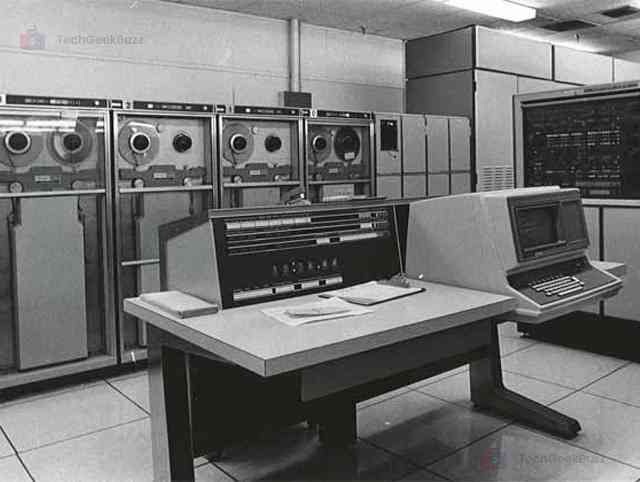
The second generation of computers dates back to the late 1950s and continued till the 1960s. Transistors were the core technology of these computers, which were relatively smaller in size than vacuum tubes. Hence, they are referred to as transistor computers.
Though the invention of transistors dates back to 1947, they were not utilized in computers. Besides being smaller in size than vacuum tubes, transistors were fast in speed, inexpensive, and energy-efficient.
Transistors were always better in terms of utility and performance than vacuum tubes. However, they also generated a lot of heat and required a dedicated cooling system to avoid failures in computers.
Another major component in the second-generation computers was the magnetic core as main memory, a form of Random Access Memory (RAM) for 20 years between 1955 and 1975. It is commonly known as a core memory or simply core. Hence, it was possible for computers to store instructions and data in memory.
Furthermore, these computers employed assembly languages and early versions of a few high-level programming languages, such as COBOL, FORTRAN, and ALGOL. They also took advantage of multiprocessing and batch-processing operating systems.
Punched cards were input devices , paper tapes were output devices , and a magnetic tape or disk was used as a secondary storage device.
IBM 7090, Honeywell H200, UNIVAC 1108, CDC 1604, CDC 3600, and IBM 7094 are some popular examples of second-generation computers.
What are Transistors?

A transistor is a semiconductor device that serves as an amplifier or switch for electric signals and power, like vacuum tubes. It features at least three terminals for connecting to an electronic circuit and is composed of semiconductor material. Each terminal has the capability to carry current.
Furthermore, a transistor acts as a switch or gate for electrical impulses, regulates the flow of current or voltage, and amplifies or produces electrical signals.
When a transistor functions as an amplifier, it converts a small amount of current into a large output current. As a switch, a transistor controls the flow of electronic signals through a circuit. It has two different states - on or off.
A transistor has three layers – an n-type semiconductor layer sandwiched between two p-type layers or vice versa. The configuration of these layers is as follows –
- The n-type layer between two p-type layers has the positive-negative-positive (PNP) configuration.
- The p-type layer between two n-type layers has the negative-positive-negative (NPN) configuration.
Characteristics of Second-Generation Computers
Let us now understand some remarkable characteristics of the second generation of computers.
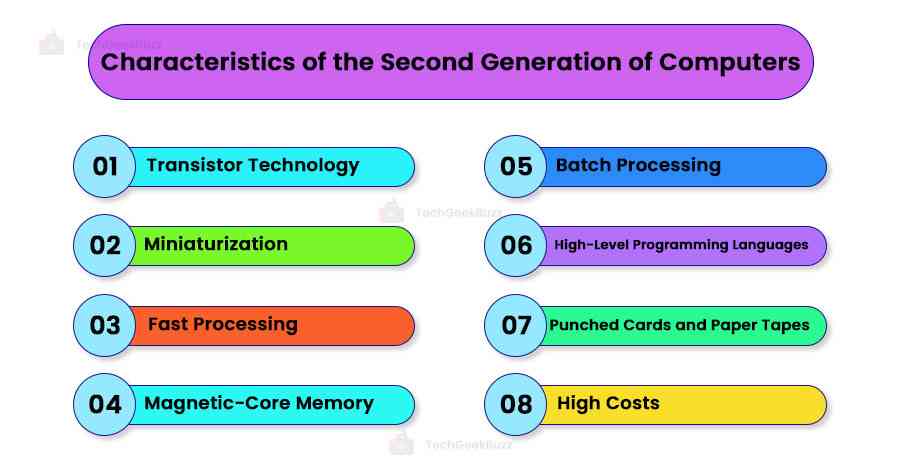
-
Transistors
Transistors were the core electronic component used in second-generation computers. Like vacuum tubes, transistors also served as an amplifier and switch. However, they were considerably smaller in size than vacuum tubes, significantly reducing the size of computers. In addition, they consumed less power and were faster and more reliable.
-
Miniaturization
The use of transistors rather than vacuum tubes made second-generation computers more compact and smaller than room-sized computers. Hence, it was easy for businesses to use and store these computers.
-
Fast Processing
Compared to their predecessors, second-generation computers were faster in processing due to the use of transistors. They enhanced computational capabilities, facilitated complex calculations, and improved the overall performance of computers. Hence, second-generation computers were much more efficient than their forerunners.
-
Magnetic-Core Memory
As discussed earlier, the second generation of computers leveraged magnetic-core memory as their primary memory . It stored data and instructions, which offered faster access time and improved reliability, resulting in enhanced overall performance of computers.
-
Batch Processing
The concept of batch processing improved the efficiency of computers and reduced the downtime between jobs. Here, users would submit certain jobs to a computer. Using batch processing, the computer would sort similar jobs and execute them without manual intervention.
-
High-Level Programming Languages
In the early development of second-generation computers, the assembly language was used to write programs. Early versions of a few high-level programming languages, such as FORTRAN, ALGOL, and COBOL, were used to write programs in the later stages of development. This made it easier for programmers to develop software.
-
Punched Cards and Paper Tapes
The second generation of computers used punched cards as input devices. A punched card, also known as a Hollerith card or IBM card, is a stiff paper that stores digital information, which is represented by the absence and presence of holes.
Paper tapes are used as output devices. A paper tape, or perforated paper, is a storage device containing a long strip of paper with punched holes to store data.
-
High Costs
Due to significant improvements in the second generation of computers, they were relatively expensive. Hence, they were not accessible to individual users. Large organizations, government agencies, and research centers could only afford computers.
Advantages and Disadvantages of the Second Generation of Computer
Second-generation computers brought a lot of benefits than their predecessors. Still, they had drawbacks. Here are some remarkable advantages and significant disadvantages of the second generation of computers.
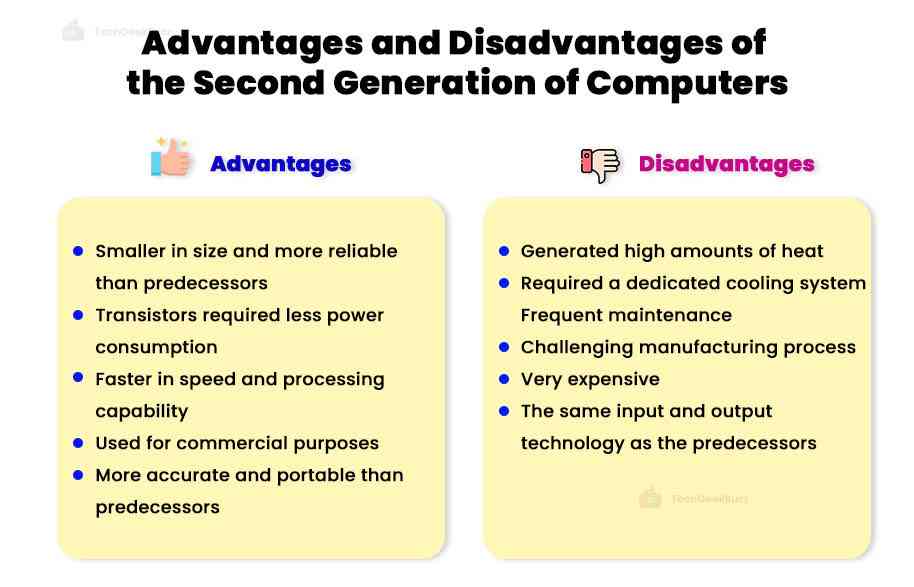
Advantages
- Second-generation computers were smaller in size and more reliable than their forerunners.
- The use of transistors required less power consumption.
- These computers were faster in terms of speed and processing capability.
- They were widely used for commercial purposes.
- They were more accurate and portable than first-generation computers.
Disadvantages
- Though second-generation computers generated less heat, they still required a dedicated cooling system.
- They required frequent maintenance and were used only for specific purposes.
- The production of these computers was a challenging task.
- They were very expensive and not as versatile as today’s computers.
- The technology used to accept input and display output was the same as first-generation computers.
Examples of the Second Generation of Computers
Now, let us have a look at some popular examples.
1. TX-0 (Transistorized Experimental Computer 0)
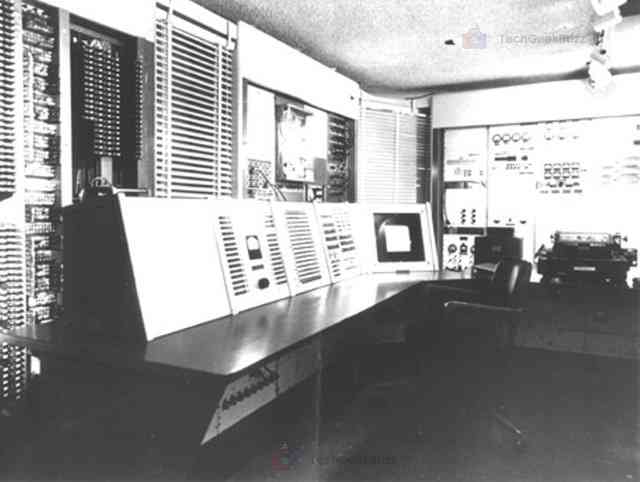
The first transistor computer was TX-0 (Transistorized Experimental Computer 0), developed at the Massachusetts Institute of Technology (MIT). This computer had two versions – the prototype, which was operational in 1953, and the full-sized version, developed in 1955.
The prototype version (the 1953 machine) had 92 point-contact transistors, 550 diodes, and a 48-bit machine word. In contrast, the full-sized version had 200 point-contact transistors and 1,300 point diodes. This resulted in high consumption of power, i.e., 150 Watts.
However, these versions of TX-0 had reliability issues, and the average error-free runtime was only 1.5 hours. In addition, they utilized a few small tubes in their clock generators. Hence, they were not fully-transistorized machines.
2. Harwell CADET
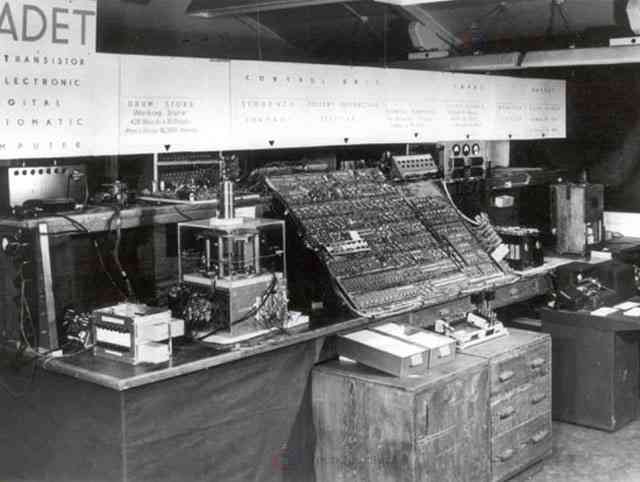
Harwell CADET is considered the first fully transistorized computer in Europe and also in the world. CADET stands for Computer Aided Design and Electronic Translation. The Atomic Energy Research Establishment at Harwell, UK, designed Harwell CADET, which became operational in 1955.
This transistor computer utilized 324 point-contact transistors and 76 junction transistors. From August 1956, this computer started delivering continuous computing service. During its execution, CADET offered computing runs of 80 hours or more.
3. IBM 7090: First Commercial Transistorized Computer
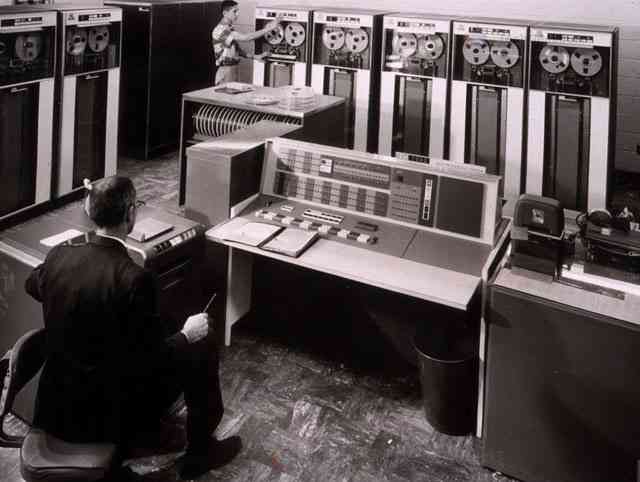
Popular as the first commercial transistorized computer, IBM 7090 was a transistorized version of the IBM 709 vacuum tube mainframe computer. It was first installed in 1959 and sold in 1960 for $2.5 million, which is equivalent to $21 million in today’s era.
IBM 7090 was six times quicker and faster than its vacuum tube computer, IBM 709. It was the high-performance computer of that time, capable of executing 100,000 instructions per second. It handled complex instructions and data processing tasks efficiently. Hence, it was used to create diverse scientific and engineering applications.
Furthermore, IBM 7090 performed 229,000 additions and subtractions/second, 39,500 multiplications/second, and 32,700 divisions/second. It had the potential to read and write 3,000,000 bits per second when it utilized all its eight data channels.
Conclusion
Here ends our discussion on the second generation of computers. Though they were not reliable and versatile as modern computers, they were improvised versions of first-generation computers. The use of transistors made a significant reduction in size, and magnetic-core memory improved access time.
Despite technological advancements, second-generation computers had a few drawbacks, such as heat generation, expensive, challenging manufacturing processes, and regular maintenance.
People are also reading:
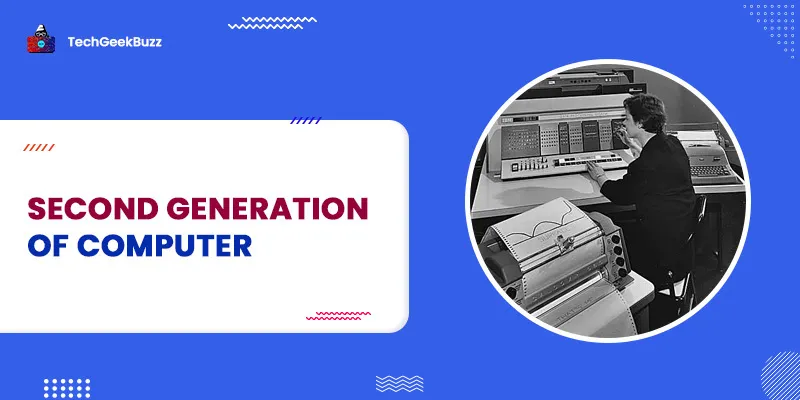

![What is an Assembler? [Definition, Working, & Types]](/media/new_post_images/What_is_Assembler.jpg)
![What is I/O? [Types, Examples, & Methods]](/media/new_post_images/What_is_I_O.webp)

Leave a Comment on this Post